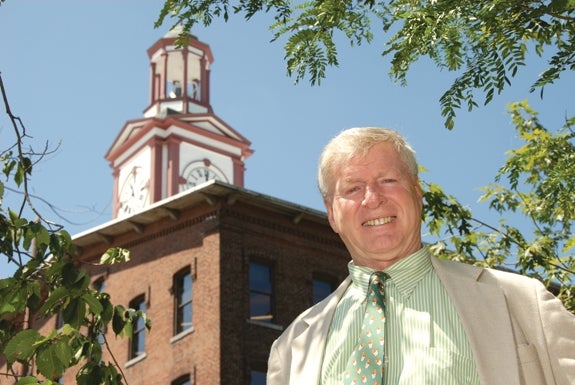Empty parking lots and shuttered buildings sprouted up in the wake of Digital Equipment Corp.’s purchase by Compaq Computer Corp. in 1998, which in turn was bought by Hewlett Packard in 2002.
At the time, the demise of DEC was viewed as a disaster for the local economy in general, and the commercial real estate market in particular.
But today, many of those former DEC buildings have since taken on new life, showing that there can be life after a big company moves out.
Heart Transplant
DEC was already undergoing competitive pressures before it was purchased by Compaq. After its founder Ken Olsen was forced out in 1992, the layoffs and consolidation of facilities began. When HP bought Compaq, it began cutting projects and people.
Here in Central Massachusetts, with its headquarters in Maynard and facilities spread out in locations from Westminster to Westborough, some parking lots and buildings became ghost towns.
In Maynard, DEC’s heart for many years was located in a 1.1 million-square-foot complex with 13 buildings. It was a former textile mill, generally referred to as “the mill” by employees.
After Olsen was out, a new president moved the company’s headquarters from the mill to a more modern building in Maynard. It was sold in 1995 to a group that wanted to make it over into a huge geriatric research and assisted living facility, which never got off the ground.
But on Jan. 1, 1998, a company called Wellesley/Rosewood Maynard Mills LP bought the mill and began working with Maynard officials to remake the property into a business hub.
“Diversity is the key word,” said Joseph Mullin, one of five director-owners of the renamed Clock Tower Place, which now has 105 tenants, including the online job board Monster.com, a day care center, some town services and many small companies like Boston Red Sox Pitcher Curt Schilling’s 38 Studios, which develops video games.
Monster.com was one of the first to sign on, and took 75,000 to 100,000 square feet.
Beyond Clock Tower Place, companies like IBM Corp., Intel Corp, Bose Corp. and Fidelity Investments have all found space in former DEC facilities.
While the companies that have taken space in these buildings may not match the size and scope of DEC, and not all buildings are full, having a variety of companies means the area no longer depends heavily on just one industry.
“There’s a good mix now. You have Bose, Genzyme as well as other life science and pharmaceutical companies,” said Kevin Hanna, an executive director at Cushman & Wakefield Inc., a New York-based international commercial real estate company with offices in Boston. “The fact that there is the diversity in the types of companies is very important,” Hanna said, adding that having so many computer-based companies up and down I-495 and Route 128 didn’t bode well for the area when that industry began to suffer financially.
Location Advantage
The story of DEC’s real estate offers some consolation to Westborough, which is set to lose a major business anchor when National Grid empties its huge offices at 25 Research Drive and moves employees to a new building in Waltham.
Clock Tower Place in Maynard has had several advantages in its efforts to rebuild in DEC’s wake. In particular, it’s been able to attract tenants through a 15-year property tax discount for the owners and a tenant tax credit and deduction program approved by Maynard selectmen in 1998.
“Government can be your partner. They have a variety of tools that can assist a developer in creating or revitalizing a project,” Mullin said.
But Mullin cautioned that prospective mill redevelopers should carefully assess their ability to recruit tenants. Maynard’s location and its downtown with shops, services and restaurants helped attract tenants, as did the lower taxes. Prospective developers should figure out whether they can carry both a mortgage and any necessary rehabilitation costs. Mullin said his bank financed the first phase, which was one building, and once that building was filled its revenues helped pay for the next improvements.
Maynard is an area that employers see as a good location for workers, he said, because it’s either convenient to a lot of them or the workers they need are already in the area.
“There are good workforce demographics there,” said Hanna describing the Central Massachusetts area. “Companies that move here can draw from a different pool of workers.”
Location is what made DEC’s buildings attractive to companies, according to John Mullin, professor of regional planning at UMass Amherst’s landscape architecture and regional planning. Joseph and John are brothers, although John is not involved with Clock Tower Place.
“The ones inside 495 went very, very quickly and most DEC buildings were in pretty good locations and were in pretty good shape,” he said.
Those further out on the fringes of the area, such as Westminster, which was a manufacturing and distribution plant, have not fared as well. Simplex bought the property and stayed in it after being purchased by Tyco Inc., but now with the subsequent reorganizing of Tyco’s business divisions, the building is underutilized.
“The neat thing was that the shift to dotcoms was already well under way when Digital began having problems and then was sold,” John Mullin said. That activity softened the impact of DEC’s problems and the locations of the buildings led other large companies to locate in them.
“Again, it goes back to location,” he said, pointing to Intel Corp.’s purchase of the Hudson plant and Fidelity’s purchase of two Marlborough buildings, as well as one in Merrimack, N.H., all of which are easy to get to and workers are available in those areas or can commute to them easily.

